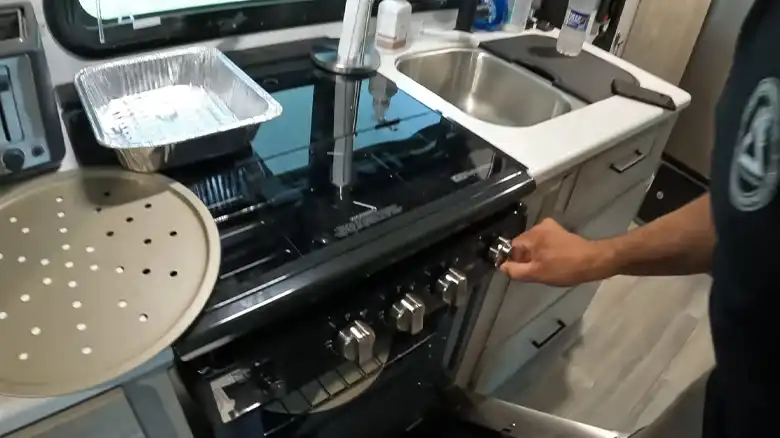A jack knife sofa, also known as a fold-down couch, is a versatile piece of furniture that folds out into a bed. When not in use, it can be folded into a compact size to save space. The ability to quickly convert into a bed makes a jack knife sofa convenient for accommodating overnight guests. However, the thin mattress and bars underneath can make these sofas quite uncomfortable for sleeping.
While jack knife sofas offer benefits like space-saving, versatility, and affordability, their biggest drawback is the lack of comfort. The minimal padding and compact size often lead to insufficient cushioning and support. This can cause body aches and an unpleasant night’s sleep. Enhancing comfort is key to helping you and your guests get a good night’s rest.
Luckily, there are several easy ways to customize your jack knife sofa to maximize comfort. With a few affordable upgrades and adjustments, you can create a relaxing sleep space perfect for naps, overnight visitors, or even everyday use. The following sections will explore tips for evaluating the mattress, adding supportive cushions, softening the surface, and more.
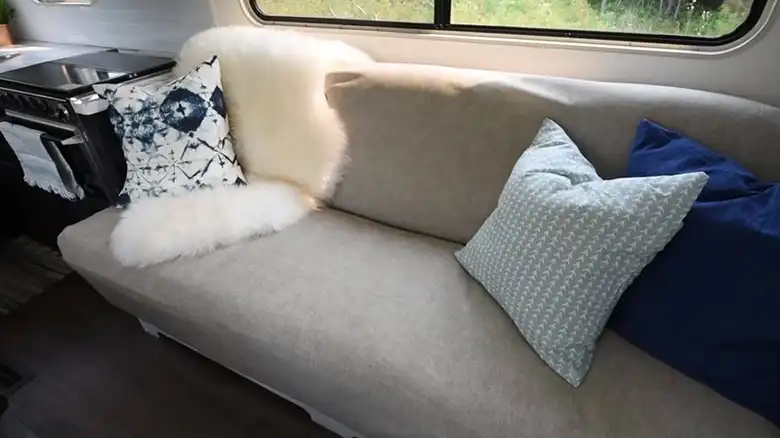
Overview of a Jack Knife Sofa
A jack knife sofa is designed to save space with its ability to fold out into a bed. This makes it convenient for accommodating overnight guests. However, the thin mattress and bars underneath often make it an uncomfortable place to sleep.
Size of a Jack Knife Sofa
Jack knife sofas come in different sizes, but when folded out they are similar to a twin or full-sized bed in length. The compact size allows them to serve as a couch or a bed based on need.
Why Is a Jack Knife Sofa Uncomfortable in An RV?
Jack knife sofas tend to be uncomfortable due to the thin mattresses, lack of cushioning, and bars underneath the folding frame. The compact design lacks the padding and support of a standard bed.
Key Ways to Improve Jack Knife Sofa Comfort in Your RV
There are several upgrades and enhancements you can make to improve the comfort of a jack knife sofa bed. Proper cushioning and support are key to making it more comfortable for sitting and sleeping.
How to Evaluate and Upgrade the Mattress
Assessing and modifying the mattress is the first step toward creating a more comfortable resting surface. The thin mattresses typical on jack knife sofa beds often lack adequate cushioning and support.
A. Assess the Current Mattress
Check cushioning, thickness, density, and firmness to see if the mattress meets comfort needs. These things briefly discussed below:
1. Level of cushioning: Check if the mattress has enough padding and cushioning. Thin mattresses usually don’t have sufficient cushioning which can cause discomfort. Evaluate if it adequately cushions pressure points in sitting and lying positions. Lack of cushioning can lead to soreness and pain over time.
2. Mattress thickness: Physically inspect and measure the mattress thickness. Thinner mattresses lead to discomfort from feeling the bars, boards and hard frame underneath while sitting or lying on the bed. Thin mattresses conform poorly to the body’s natural curves.
3. Mattress density: Evaluate if the mattress density provides adequate softness, support and conformation. Ultra firm high density foam can feel too hard and unyielding. Low density foam may lack support. Medium densities often optimize comfort and support.
4. Mattress firmness: Determine if the mattress is too soft or too firm for your preferences. Soft mattresses contour better initially but allow more sinkage. Extra firm mattresses don’t adapt well to body shape. Medium firmness around 5-7/10 is typically preferred by most people for best comfort.
B. Replace or Upgrade (If Needed)
1. Memory foam toppers: Adding a 2-6 inch memory foam mattress topper can substantially increase softness, cushioning and body conforming ability. This greatly enhances comfort without buying a whole new mattress. Memory foam molds to the body’s natural contours.

2. Egg crate foam pads: Egg crate and convoluted foam pads provide additional cushioning and support for targeted areas like the back and hips. Can be used alone or in conjunction with another topper. Helpful for side sleepers.
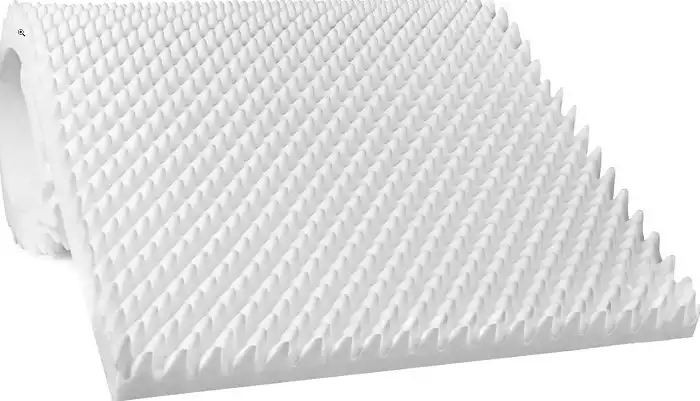
3. Fibered mattress pads: Fibered mattress pads supply extra padding through alternative materials like polyester. Can provide extra comfort and improve breathability compared to foam alone. Useful for adding softness.
4. Pillow top for mattresses: Attaching or placing a pillow top foam/fiber layer over the mattress creates a plush, cushioned surface for greater comfort. Pillow tops provide initial softness before firmer support layers. They contour well and improve pressure relief.
Enhancing Comfort with Supportive Cushions
Additional supportive cushions can supplement mattress comfort in targeted areas.
A. Back cushions
1. Lumbar pillows: Lumbar pillows are placed against the inward curve of the lower back to improve support and seated comfort. They help maintain the natural arch of the spine’s lumbar region. Quality lumbar cushions are made of firm supportive foam or have internal stiffness elements to prevent the lower back from collapsing into a rounded position for extended periods. Lumbar support aids posture and can help reduce back pain.
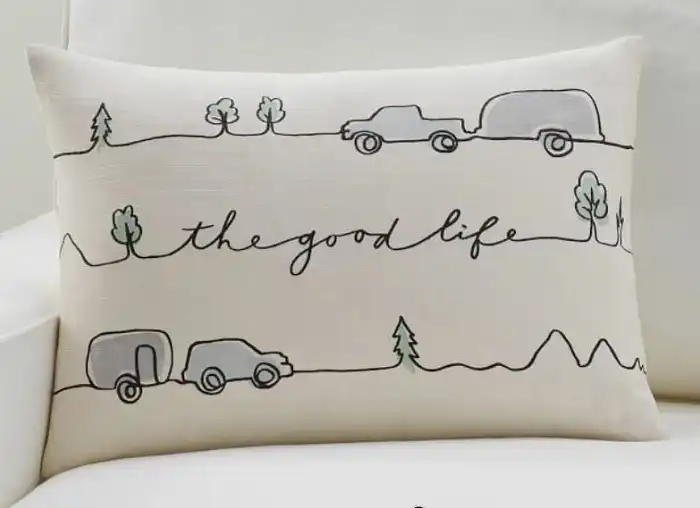
2. Bolsters: A full-length cushion shaped like a long cylinder can cushion the entire back while seated. Back bolsters allow the spine to rest against a soft but supportive surface, maintaining the natural S-shaped curve of the back. This helps relax back muscles and ligaments so they don’t have to actively support the weight of the upper body against gravity. Bolsters should have an even surface and medium firmness.
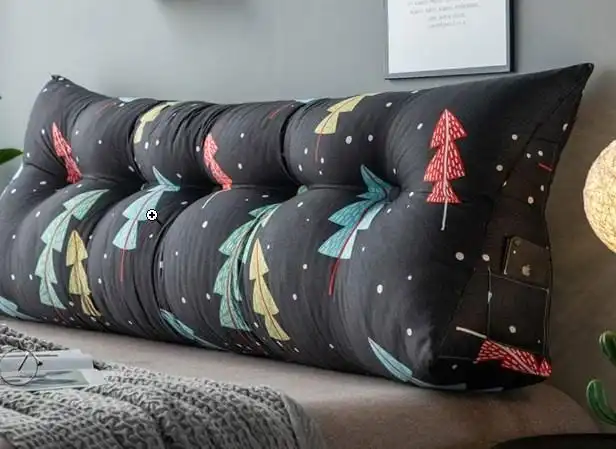
3. Accent pillows: Smaller throw pillows or cushions can provide supplemental support to specific areas of the back like the lower and mid back regions. They can be placed where extra reinforcement is needed by the individual based on their preferences, posture, body shape, pre existing conditions, etc. Accent pillows provide comfort through conforming softness and additional thickness in targeted zones.
B. Seat Cushions
1. Foam cushions: Firm, high-density foam seat cushions can supply ample padding beneath the pelvis and upper thighs to cushion hard sitting surfaces. This evens out pressure distribution over the contact area and enhances stability, comfort and circulation in the seated position over long periods. Seat cushions shaped with contours or cut-out areas provide tailbone relief.
2. Inflatable cushions: Inflatable seat pads offer customizable thickness and compression support since users can inflate to their preferred firmness level. Self-inflating cushions mold to body shape. Some provide adjustable lumbar or coccyx support zones. Inflatable nature aids portability.
3. Wedge cushions: Wedge cushions are triangular segments rising from thin front edges up to thicker back edges. This inclined slope tilts the pelvis slightly forward to promote a natural seated posture. The wedge shape helps reduce pressure and sliding for stable cushioning. It effectively cups the buttocks/thighs at favorable angles.
C. Head Cushions
1. Bolsters: Full body-length bolsters placed vertically against the armrest allow for comfortable head and neck support on either side. The soft, rounded sides of the bolster act as an extension of the sofa’s armrests, but with more cushioning area for the head to rest on. The bolsters should have enough firmness to prevent excessive neck flexion without being overly hard. Having head cushion support reduces strain.
2. Armrest pillows: Smaller pillows specifically placed along the exterior edges of the sofa’s built-in armrests effectively raise the height and width of those armrests. This allows the head and neck to rest at an elevated, supported angle to enhance relaxation. Multiple stacked pillows can customize height and angle as needed.
3. Neck rolls: Neck rolls are small cylindrical pillows designed to cradle the natural cervical curve at the back of the neck for proper head and neck positioning. They provide a soft but supportive surface right under the neck area. This helps sustain the weight of the head without awkward bending of the neck which could cause muscle cramping or fatigue while resting. Maintaining spinal alignment reduces discomfort.
Layering Throws, Blankets, and Sheets for Comfort
Layering blankets, throws and sheets on top of the mattress alters the texture and thermal properties of the sleeping surface for greater comfort.
A. Throws and blankets to soften surface: Placing soft throws and blankets on top of the mattress pad before bedding sheets helps create a more cushioned and luxurious surface texture for sleeping or lounging. Lovely woven throws and light quilts boost aesthetics while their inherent flexibility allows them to conform to the body’s natural curves, reducing pressure points. Lighter blankets provide coziness without heat retention making them comfortable year-round. The added loft and breathability improve the overall comfort.
B. Breathable sheets and mattress pads: Fitted sheets and mattress pads designed from natural fibers like cotton and bamboo rayon offer superior ventilation and moisture wicking. Unlike synthetics, breathable fabrics minimize heat retention and allow perspiration vapor to dissipate so sleepers stay comfortably dry. Naturally breathable sheets are soft, lustrous, antimicrobial and promote healthy skin. Mattress pads give a smooth, consistent texture for sheets so the surface feels uncompromised by bars underneath.
C. Heated blankets for warmth: For particularly cold nights, electric heating blankets and throws provide user-controlled warmth underneath regular bedsheets. Heating elements are safely encased in soft, flexible fabrics. Besides a cozier bed, heated throws boost blood circulation and ease muscle soreness while lounging. Multiple heat settings reach optimum warmth for deep relaxation without messy loose blankets or baking sheets. Auto shut-offs prevent overheating or accidental fires. Heated bedding allows personalized comfort independent of room thermostat settings.
Advantages of Using a Jack Knife Sofa
A jack knife sofa offers several beneficial features that make it a versatile, convenient furniture option:
Space Saving: The main advantage of a jack knife sofa is its ability to fold down into a very compact size. Unfolding into a bed, chair, or chaise lounge configuration allows it to serve multiple needs while conserving space in smaller homes, apartments, offices, recreational vehicles, etc. The slim profile when closed is an enormous space saver compared to a typical bed, couch or reclining chair.
Affordability: Relative to purchasing separate living room and bedroom furniture pieces, the 2-in-1 jack knife sofa bed comes at an affordable price point. Cost savings come from the shared frame and compact, lighter design. The simple mechanism and materials keep manufacturing costs lower as well. This makes it very budget friendly.
Quick Conversion: Jack knife sofas quickly convert between their compact, upright form and a flat, usable surface thanks to the convenient fold-out frame requiring only one step to unlock and deploy. The easy transformation takes under a minute unlike disassembling other furniture pieces. This allows speedy living space adjustments.
Adaptability: The jack knife frame adjusts to various angles and configurations. Besides a basic twin-sized bed, customized positioning creates space for lounging, reading, working on a laptop, watching TV, etc. The light-duty frame also works well outdoors for napping, stargazing or guest camping. Adaptability maximizes functionality.
Portability: Integrated handles plus builtin wheels on some models allow jack knife sofas to be conveniently transported between rooms or loaded into vehicles fairly easily for camping trips. The folding functionality helps fit into vans and mobile homes. For small living spaces that move occasionally, portability is key.
The versatility of form, affordable pricing, and space/weight efficiency give jack knife sofa beds an advantage over bulkier furnishings with single-purpose roles. Their flexibility accommodates life’s changing needs.
Common Causes of Discomfort in Jack Knife Sofas
While the jack knife sofa stands out for its convenience, the matter of comfort often becomes a difficulty for some sleepers. Let’s discuss the factors that weave the fabric of discomfort within these versatile pieces.
1. At the forefront of jack knife sofa discomfort lies the unyielding nature of its sleeping surface. The practicality of the design sometimes takes precedence over comfort, resulting in a firmness that doesn’t cater to the nuances of a restful sleep.
2. The transition to bed form unveils a notable challenge—a noticeable gap between the back and seat cushions. This void creates an uneven sleeping surface, introducing discomfort that can be particularly pronounced during a night’s rest.
3. Designed with a focus on space-saving versatility, jack knife sofas occasionally sacrifice immediate comfort. The emphasis on multifunctionality can relegate the importance of a soothing sleep experience to a secondary role.
4. Opting for leather or leatherette upholstery in crafting jack knife sofas adds another layer to the discomfort narrative. While visually appealing, these materials may lack the softness and breathability crucial for a serene sleep environment.
5. The metal framework, typically hewn from steel, forms the backbone of jack knife sofas. However, an unsupported extension can lead to a bowed sleeping surface, introducing an undesirable variable to the comfort equation.
6. An unmistakable absence exacerbates the discomfort—the lack of a dedicated mattress. In stark contrast to traditional beds, jack knife sofas compel individuals to rest directly on the sofa’s structure, missing the essential cushioning for a truly restful slumber.
The discomfort mixed into the jack knife sofa experience emerges from a delicate interplay of factors—from unyielding surfaces and cushion gaps to the prioritization of versatility over immediate comfort.
Adjusting Your Sleeping Position for Better Comfort
Minor changes in sleep positioning can markedly improve comfort on the thinner jack knife mattress.
A. Sleep with knees bent: Sleeping in a loosely fetal position with knees bent upwards and a small pillow between the legs aligns the spine properly. This takes pressure off the lower back helping it retain its natural lumbar curve all night. The slightly bent legs encourage relaxation of core and hip muscles that otherwise have to strain supporting the torso. Knees bent helps the body sink into the mattress a bit more as well.
B. Use nighttime wedges: Supportive foam wedges and cushions strategically alter sleeping angles. A graduated wedge pillow gently slants the torso to prevent rolling onto the stomach or flat on the back—two positions exacerbating back discomfort. Wedges also support better spine, hip and shoulder alignment relieving tension. Supportive leg wedges between knees further helps pelvic tilt and lumbar health.
C. Add pillows for alignment: The right combination, thickness and positioning of pillows customizable supports the head, neck, shoulders and extremities during rest. Plush pillows beneath knees while side sleeping keeps the spine elongated. A body pillow aids shoulder positioning. Cervical pillows align the neck and evenly fill space beneath the head. Pillows essentially help bridge any gaps between the body and mattress.
D. Alternate direction: Periodically alternating the direction you lie down helps distribute pressure more evenly across the mattress long-term. The jack knife bed frame contains a lengthwise bar down the middle that can feel uncomfortable lying atop it all night. Switching longitudinal orientation allows pressure points to vary so no one area feels strained.
Expert Tips to Maximize Comfort on Your Jack Knife Sofa
Besides do-it-yourself enhancements, consider consulting experts for custom comfort solutions.
A. Seeking professional upholstery services: For major modifications like replacing mattress padding, covers and cushioning layers, consult professional upholsterers. They can methodically install new materials, foams or inner springs suited to individual needs and body types. Custom workmanship also looks integrated rather than makeshift add-ons. Take advantage of artisan experience in ergonomics, fabrics and filling options.
B. Consulting furniture experts: Furniture salespeople, interior designers and ergonomists can provide personalized guidance choosing jack knife sofa beds for intended usage: everyday lounging vs. spare guest bed vs. outdoor camping furniture. They help select ideal mattress thickness, fold-out configurations, layered cushions, mattress toppers and beddings for maximum comfort per customer priorities like firmness preference and physical limitations. Customized professional recommendations suit personal needs.
Leveraging external expertise helps build upon standard off-the-shelf components to create a tailored jack knife sofa offering superior comfort and years of enjoyment. Customer-centric adjustments make good financial sense rather than purchasing overly plush sofas exceeding space constraints.
Final Thoughts
Evaluating and upgrading the mattress, adding supportive cushions, layering blankets and adjusting sleep positions are key ways to tailor a jack knife sofa for greater comfort. Customizing it to meet individual needs is pivotal for restful sleep. Regular sofa maintenance will sustain optimal coziness and proper spinal alignment during use, maximizing long-term jack knife sofa comfort.


